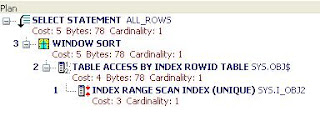/*+NO_QUERY_TRANSFORMATION*/
The NO_QUERY_TRANSFORMATION hint causes the optimizer to skip all query transformations including but not limited to OR expansion,view merging, subquery unnesting, star transformation and materialized view rewrite.use the "NO_QUERY_TRANSFORMATION" hint to disable most of the transformations , although some transformations still seem to take place, e.g. IN seems to be always transformed into EXISTS .
This hint which improve performance to a great extent for my Spatial query.
SELECT /*+ NO_QUERY_TRANSFORMATION*/ * FROM CABLE WHERE MDSYS.sdo_filter
(shape,MDSYS.SDO_GEOMETRY (2003,3785,NULL,MDSYS.sdo_elem_info_array (1,1003,3),MDSYS.sdo_ordinate_array (-9003954.980329761, 4271239.694744173, -9003673.417374918, 4271428.398654524)),'querytype=WINDOW') = 'TRUE' and (sdo_RELATE(shape, (SELECT geom FROM user_boundary WHERE userid = 103),'MASK=INSIDE') = 'TRUE') ORDER BY OID
Execution Time : 47msec
SELECT * FROM CABLE WHERE MDSYS.sdo_filter
(shape,MDSYS.SDO_GEOMETRY (2003,3785,NULL,MDSYS.sdo_elem_info_array (1,1003,3),MDSYS.sdo_ordinate_array (-9003954.980329761, 4271239.694744173, -9003673.417374918, 4271428.398654524)),'querytype=WINDOW'
) = 'TRUE' and (sdo_RELATE(shape, (SELECT geom FROM user_boundary WHERE userid = 103),'MASK=INSIDE') = 'TRUE') ORDER BY OID
Execution Time : 1:09 min
....
if you execute this spatial query without this hint it take around 3 minutes to execute ! amazed
If you want dumps you can mail us :oracleplsql10g@gmail.com
The cost of a query is not proportional to the time execution of a query for example If cost of a query (A) is greater than cost of another query (B) then its not always query (A) takes more execution time than query (B) .
............
Try this simple query too
SELECT /*+ NO_QUERY_TRANSFORMATION */
shape FROM cable WHERE (sdo_relate (shape,(SELECT geom FROM user_boundary WHERE userid =103),'MASK=INSIDE')='TRUE')
SELECT shape FROM cable WHERE (sdo_relate (shape,(SELECT geom FROM user_boundary WHERE userid =103),'MASK=INSIDE')='TRUE')
----------------------
These queries may get executed when no query transformation hint is not given for in some case
SELECT diminfo FROM all_sdo_geom_metadata WHERE owner = :own AND table_name = :tab AND column_name = :col
SELECT sdo_relation FROM sdo_relatemask_table WHERE sdo_mask = :b1
So evaluate your query and the data in the tables and check execution plan in both scenario and its performance and decide .
The NO_QUERY_TRANSFORMATION hint causes the optimizer to skip all query transformations including but not limited to OR expansion,view merging, subquery unnesting, star transformation and materialized view rewrite.use the "NO_QUERY_TRANSFORMATION" hint to disable most of the transformations , although some transformations still seem to take place, e.g. IN seems to be always transformed into EXISTS .
This hint which improve performance to a great extent for my Spatial query.
SELECT /*+ NO_QUERY_TRANSFORMATION*/ * FROM CABLE WHERE MDSYS.sdo_filter
(shape,MDSYS.SDO_GEOMETRY (2003,3785,NULL,MDSYS.sdo_elem_info_array (1,1003,3),MDSYS.sdo_ordinate_array (-9003954.980329761, 4271239.694744173, -9003673.417374918, 4271428.398654524)),'querytype=WINDOW') = 'TRUE' and (sdo_RELATE(shape, (SELECT geom FROM user_boundary WHERE userid = 103),'MASK=INSIDE') = 'TRUE') ORDER BY OID
Execution Time : 47msec
SELECT * FROM CABLE WHERE MDSYS.sdo_filter
(shape,MDSYS.SDO_GEOMETRY (2003,3785,NULL,MDSYS.sdo_elem_info_array (1,1003,3),MDSYS.sdo_ordinate_array (-9003954.980329761, 4271239.694744173, -9003673.417374918, 4271428.398654524)),'querytype=WINDOW'
) = 'TRUE' and (sdo_RELATE(shape, (SELECT geom FROM user_boundary WHERE userid = 103),'MASK=INSIDE') = 'TRUE') ORDER BY OID
Execution Time : 1:09 min
....
if you execute this spatial query without this hint it take around 3 minutes to execute ! amazed
If you want dumps you can mail us :oracleplsql10g@gmail.com
The cost of a query is not proportional to the time execution of a query for example If cost of a query (A) is greater than cost of another query (B) then its not always query (A) takes more execution time than query (B) .
............
Try this simple query too
SELECT /*+ NO_QUERY_TRANSFORMATION */
shape FROM cable WHERE (sdo_relate (shape,(SELECT geom FROM user_boundary WHERE userid =103),'MASK=INSIDE')='TRUE')
SELECT shape FROM cable WHERE (sdo_relate (shape,(SELECT geom FROM user_boundary WHERE userid =103),'MASK=INSIDE')='TRUE')
----------------------
These queries may get executed when no query transformation hint is not given for in some case
SELECT diminfo FROM all_sdo_geom_metadata WHERE owner = :own AND table_name = :tab AND column_name = :col
SELECT sdo_relation FROM sdo_relatemask_table WHERE sdo_mask = :b1
So evaluate your query and the data in the tables and check execution plan in both scenario and its performance and decide .



